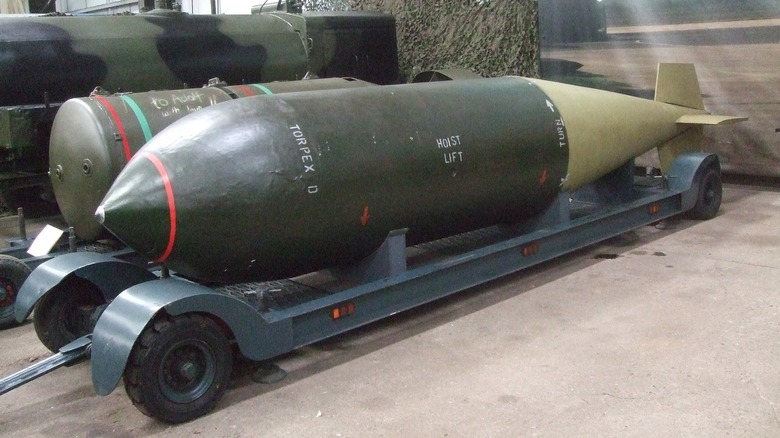This WW2 'Earthquake Bomb' Was Designed To Miss Its Target. Here's Why
If you've seen the 1955 film, "The Dam Busters," then you might be familiar with Barnes Wallis, an English engineer and inventor best known for building an assortment of peculiar explosives used effectively during World War II. The movie focused on the very real 1943 mission codenamed Operation Chastise, where the British Royal Air Force (RAF) used Wallis' "bouncing" bombs to blow dams along the Ruhr Valley — a central Nazi industrial region.
These bombs were designed to essentially skip across the water — avoiding torpedo net countermeasures. It's this outside the box thinking that Wallis was known for throughout his career. Before bouncing bombs, he created geodetic airframes — which proved sturdier than most fuselage designs at the time.
Wallis' next invention stemmed from the need to bust bunkers. It's hard to know the exact number the Nazis built, but estimates place them over 25,000.
German bunkers were notoriously difficult to penetrate, from the Atlantic Wall to the 7,500-square-foot Tirpitz Bunker in Denmark. One such 26-foot thick steel reinforced concrete roof protected submarine pens at Saint-Nazaire, France, while the La Coupole bunker, which fired V-2 rockets, was covered by a dome made of 55,000 tons of concrete and was 16 feet thick.
Conventionally dropped bombs had no chance of damaging structures like these. So, using unconventional thinking, Wallis devised one that could miss its intended target yet still create enough destruction to demolish it.
[Image by Richard Hoare via Wikimedia Commons | Cropped and scaled | CC BY-SA 2.0]
Britain's' Tallboy could really shake the earth
In 1941, Wallis wrote a paper that explained how Allied forces could drop a massively heavy bomb near a target that would burrow deep into the ground and then explode. The resulting explosion would unleash a shockwave so powerful that it could wreck the very foundations of a building, thereby weakening it enough to penetrate it.
The idea wasn't to score a direct hit and demolish a target the old-fashioned way, but to cause (for lack of a better word) an earthquake that rendered it completely useless. Scientifically, we know shockwaves travel faster and more efficiently through solids than air, so the idea had merit, and the British RAF gave the go-ahead for Wallis to experiment with making such a bomb.
Enter the Tallboy. Not to be confused with a can of beer that weighs one pound, this Tallboy was a 12,000-pound bomb. Previously, the heaviest available weighed a mere 1,000 pounds. At 21 feet tall, Wallis' creation lived up to its name.
With a diameter of 3 feet 8 inches and a total weight of 11,855 pounds (5,200 of which were Torpex D1, an explosive twice as powerful as TNT), Tallboy was a heavyweight that packed a punch. When dropped from 20,000 feet it made a crater 80 feet deep and 100 feet across. Tallboy had an estimated terminal velocity around 3,600 feet per second and could slice through 16 feet of concrete. It hit the ground traveling some 750 miles per hour.
Over 700 were dropped during the war on hundreds of targets, including the German battleship Tirpitz.
